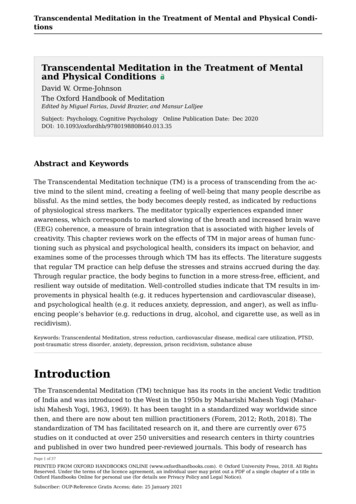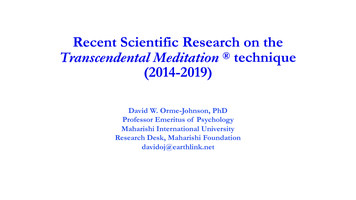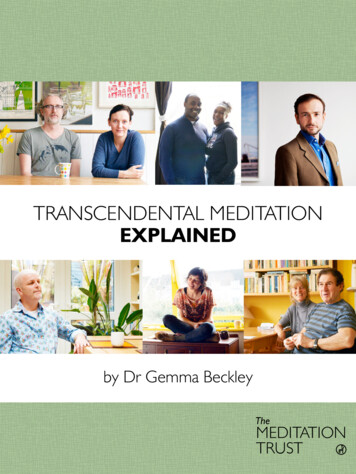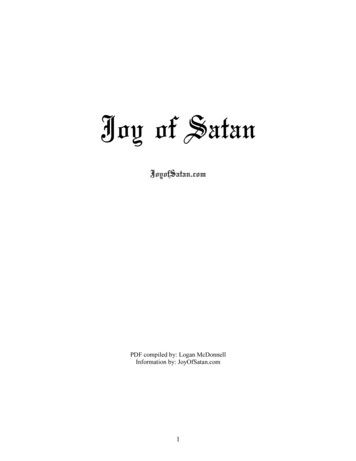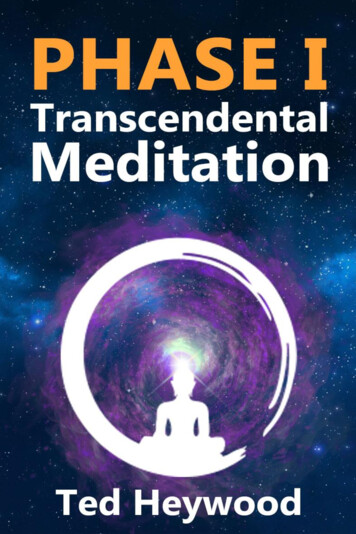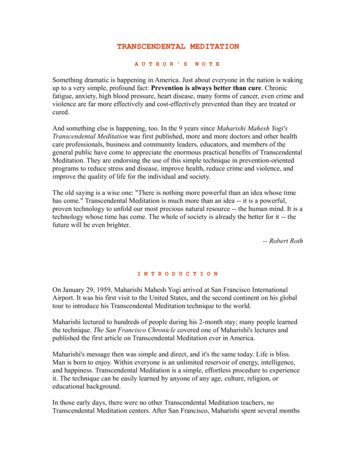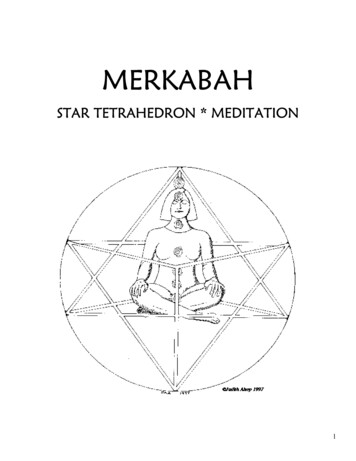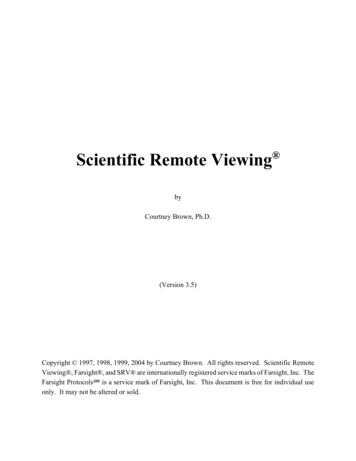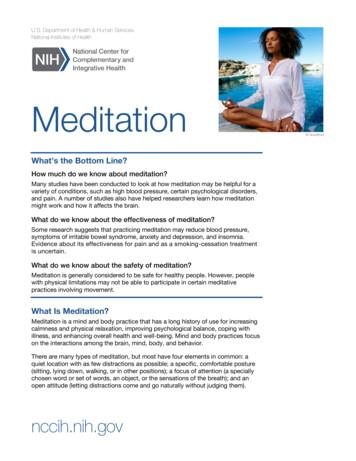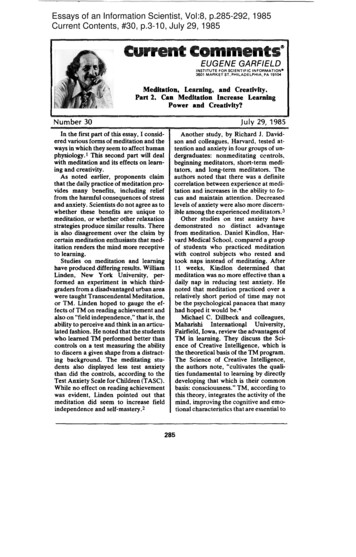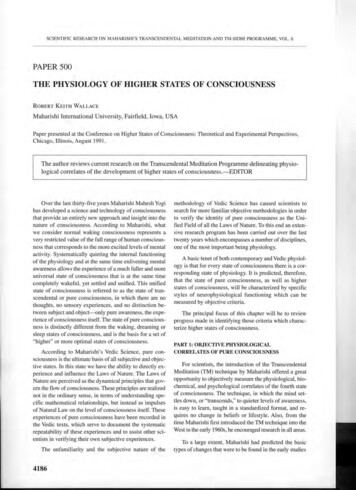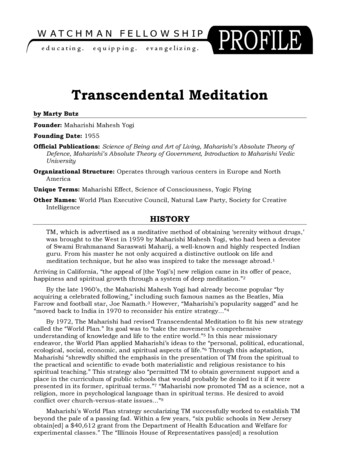
Transcription
Transcendental Meditationby Marty ButzFounder: Maharishi Mahesh YogiFounding Date: 1955Official Publications: Science of Being and Art of Living, Maharishi’s Absolute Theory ofDefence, Maharishi’s Absolute Theory of Government, Introduction to Maharishi VedicUniversityOrganizational Structure: Operates through various centers in Europe and NorthAmericaUnique Terms: Maharishi Effect, Science of Consciousness, Yogic FlyingOther Names: World Plan Executive Council, Natural Law Party, Society for CreativeIntelligenceHISTORYTM, which is advertised as a meditative method of obtaining ‘serenity without drugs,’was brought to the West in 1959 by Maharishi Mahesh Yogi, who had been a devoteeof Swami Brahmanand Saraswati Maharij, a well-known and highly respected Indianguru. From his master he not only acquired a distinctive outlook on life andmeditation technique, but he also was inspired to take the message abroad.1Arriving in California, “the appeal of [the Yogi’s] new religion came in its offer of peace,happiness and spiritual growth through a system of deep meditation.”2By the late 1960’s, the Maharishi Mahesh Yogi had already become popular “byacquiring a celebrated following,” including such famous names as the Beatles, MiaFarrow and football star, Joe Namath.3 However, “Maharishi’s popularity sagged” and he“moved back to India in 1970 to reconsider his entire strategy.”4By 1972, The Maharishi had revised Transcendental Meditation to fit his new strategycalled the “World Plan.” Its goal was to “take the movement’s comprehensiveunderstanding of knowledge and life to the entire world.”5 In this near missionaryendeavor, the World Plan applied Maharishi’s ideas to the “personal, political, educational,ecological, social, economic, and spiritual aspects of life.”6 Through this adaptation,Maharishi “shrewdly shifted the emphasis in the presentation of TM from the spiritual tothe practical and scientific to evade both materialistic and religious resistance to hisspiritual teaching.” This strategy also “permitted TM to obtain government support and aplace in the curriculum of public schools that would probably be denied to it if it werepresented in its former, spiritual terms.”7 “Maharishi now promoted TM as a science, not areligion, more in psychological language than in spiritual terms. He desired to avoidconflict over church-versus-state issues.”8Maharishi’s World Plan strategy secularizing TM successfully worked to establish TMbeyond the pale of a passing fad. Within a few years, “six public schools in New Jerseyobtain[ed] a 40,612 grant from the Department of Health Education and Welfare forexperimental classes.” The “Illinois House of Representatives pass[ed] a resolution
THE BEST RESOURCE COLLECTION ON CULTS AND RELIGIONSThe Watchman Fellowship ProfileNotebook provides you with an extensive personal library of information about cults, new and alternative religions, world religions, andreligious leaders. You will have atyour fingertips over twenty years ofresearch to answer your questions,strengthen your faith, and improveyour witness to others. Over 100 ProfilesOver 400 pages of informationThe history and primary teachings ofeach groupA Christian responseto deepen your faithand enhance your outreachClick here to order your copy of the watchman fellowship profile notebookBe sure to also order your free subscription to the Watchman Fellowship Profile. Several timeseach year you will receive a new, four-page Profile that you can add to your Profile Notebook, aswell as the latest news from Watchman Fellowship. Click here to order your free subscription!
Transcendental Meditation, page 2encouraging schools to offer TM courses. “The federal government fund[ed] 17 TM researchgrants.”9 When the Maharishi appeared on the “Merv Griffin Show” in 1975, TM waspersonally and positively endorsed by the show’s host and other guests to almost 30million viewers. Merv Griffin’s comments that TM was being taught in many public schoolsystems and used by businesses, hospitals, athletic teams and the military did much topromote TM’s image.10 By the end of 1975, two books on the best seller list were about TMand TM had entered “a new era of respectability as professionals, business people,professional athletes and members of Congress” became meditators.11However, after 1975, TM’s fortunes took another turn. The “number of new peopletaking TM courses dropped significantly.” In response, “the TM leadership announced anadvanced program which purported to teach meditators to levitate and to vanish at will.”Such outrageous claims “tarnished the scientific image of TM” which TM had strived tocreate and, as a result, the organization lost credibility.12 When “a federal court ruled thatTM was a religious practice,” and the ruling was upheld in the U.S. Court of Appeals 3rdDistrict,13 TM was then made “subject to the establishment clause of the U.S.Constitution,”14 not only denying TM the privilege of receiving federal funds, butpreventing it from being taught in public schools, one of the key markets for TM.15In addition to these setbacks, TM began to become criticized as actually beingharmful, rather than beneficial, to some TM practitioners. In 1978, Psychology Todaymagazine reported that a “‘substantial number’ of meditators developed anxiety,depression, physical and mental tension and other adverse effects.”16 “In 1980, the WestGerman government’s Institute for Youth and Society produced a report calling TM a‘psychogroup’ and saying that the majority of people who went through TM experiencedpsychological or physical disorders.”17The TM organization responded to the critical reports and studies by citing otherresearch studies indicating the beneficial results of meditation. However, many of thesesame studies also came under criticism, being observed that they often lacked credibilityfrom not being “independently established through rigorous scientific testing.”18 BeyondTM’s frequent failure to cite research maintaining high scientific standards, it wasobserved that the “TM movement’s marketing practices” suggested “a widespread patternof misinformation, deception, and manipulation of lay and scientific news media aimed toearn both respectability and profits.”19Along those lines, some former practitioners of TM, those who took advanced coursesor studied to become teachers, began suing the organization in the late 1980’s.Accusations that TM and its associated organizations were “organized as a cult,”“implement[ed] a fraudulent scheme involving thought-reform techniques” and “swindled”members of their “money,” “labor” and a significant portion of their lives were typical ofsome of the charges made by those suing the organization.20 One former member, RobertKropinski, charged that the TM organizations “falsely promised he could learn to fly,” butin reality taught students to “hop with the legs folded in the lotus position.” Though heeventually lost the case on appeal, he was originally awarded 137,890 by a federal courtafter the TM organizations were found guilty for “fraud and negligence.”21Transcendental Meditation ventured into the political realm when, in 1992, theNatural Law Party was founded on the property of the Maharishi International University’scampus in Fairfield, Iowa. The creation of “the U.S. party, one of about 40 similar partiesin countries around the world, followed a directive from the Maharishi in the early 1990’sthat his followers get involved in politics.”22 Using “TM-based ideas to advocate solutionsfor improving people’s health, fighting crime, cleaning up the environment, balancing thebudget and a flat tax,” the Natural Law Party has established a broad political platform.Many Natural Law Party candidates, including the party’s past presidential candidate,John Hagelin, have denied any formal connection between the party and the TMmovement. Nevertheless, there are an abundance of “informal ties” and the Natural Party’sspokesman himself, Bob Roth, has stated that “There has been extensive coverage aboutTM and the party. It’s no secret that this is the TM party.’” In 1995, “virtually all of the
Transcendental Meditation, page 3dozens of candidates for Congress and the state Legislature in California [fielded were]practitioners of Transcendental Meditation.”23Today, while “dozens of studies [have shown] the harmful effects of meditation,”24 TMcontinues to be “the most widely practiced form of meditation in the country. Thousandsof schoolteachers have become meditators through this system and many have encouragedtheir students to practice TM as well. Although TM has legally been expelled from theclassroom. in some school systems its procedures continue to be taught.”25 In the late1990’s, it was estimated that the “Maharishi Mahesh Yogi’s TM enterprise was worthbetween three billion and four billion dollars.”26DOCTRINETranscendental Meditation (TM) is the offspring of Hinduism, an eastern religioustradition. On a personal level and in a practical sense, TM “is a spiritual practice calledyoga which is presented to the Western world as a ‘scientific’ way of reducing stress andfinding peace within oneself.”27 It promises “ultimate results with minimal effort,”28requiring just 20 minutes of meditation twice a day. Yet, on a cosmic level, TM’s “WorldPlan intends to.relieve problems that have plagued humankind for centuries. In itsembrace of these utopian objectives TM can legitimately be regarded as a type of millennialNew Age movement.”29While the TM movement strives to couch its concepts in scientific language or neutralterms, and while it promotes “its medicinal benefits as a form of relaxation,” TMnevertheless “incorporates clearly pantheistic ideas into its approach. Though thetechniques can be learned in a purely mechanical way, answers to ‘How?’ and ‘Why?’inevitably take the novice into the realm of Eastern philosophy.”30God: The Maharishi taught “The one eternal unmanifested absolute Being manifestsitself in many forms of lives and existences in creation,”31 Hence, it is easy to concludewith Elliot Miller that “The God of TM is.pantheistic.”32 (pantheism being that viewwhich “denies the personality of God and equates God with the forces and laws of theuniverse”33).Man’s Nature: Maharishi teaches that human nature is basically good andunblemished, declaring that “‘Simplicity and innocence are already deeply rooted in thevery nature of each individual.’” When he also says, “The impersonal God is the Beingwhich dwells in the heart of everyone. Each individual is, in his true nature, theimpersonal God,”34 one cannot doubt that Maharishi views man as essentially good.Man’s Problem: As Gordon Lewis has observed, “Man’s ultimate need, according toTM, is for.a state of consciousness called Unity” and specifically that, “According to thediagnosis of the Maharishi, man’s deepest difficulty is his lack of consciousness of his owndivine Being. Instead of attaining consciousness of God, people try to be good or merelythink about God.”35 To quote Maharishi himself, “All misery in the world is due to missingthis one point.”36Man’s Salvation: Maharishi has taught others to “be still and know that you are Godand when you know that you are God you will begin to live Godhood.”37 As it has beenobserved, “According to Maharishi, man has forgotten his inner divinity through the loss ofthe simple technique of experiencing it. The lost technique is TM.”38Through the Puja, an “initiation rite.where the meditation is taught,” one goesthrough a “a Hindu ceremony worshiping the Hindu deities and offering them sacrifices offruit, flowers, and cloth.”39 As Miller notes, “It is only after this ceremony has beenperformed that one may receive his mantra to meditate upon.”40 The mantra is “given bythe master to a follower.as a kind of weapon to ward off reasoning, thinking, andconceptualization and unite the meditator with the divine within him. It is a sound withoutmeaning, like OM, the vibrations of which lead to union with one’s Source,” writes Lewis.41
Transcendental Meditation, page 4Significantly, “Maharishi himself admits that the use of the mantra invokes gods andspirits from the spirit world.”42CHRISTIAN RESPONSEBecause Maharishi and the TM movement have claimed that TM is not a religion,“Jewish, Protestant, and Catholic leaders have endorsed TM to their congregations, andmany practice it themselves. But TM is Hinduism. Its origin, initiation rite, nature,practice, and theory are all religious at the core.”43 “Contrary to TM’s current claims, TM isa Hindu religious system and is not compatible with Christianity. It denies the centraldoctrines of the Christian faith and asserts the futile Hindu system of monism andmaya,”44 where monism asserts that there is “no ultimate distinction between.good orevil, or Creator and creature,”45 and maya asserts that “the world.is not what it appears”to be.46It is clear that, within the TM movement, the idolatrous pagan rite of the Puja(contrary to Exodus 20:2–5), the failure to see, much less honor, the clear distinctionbetween creature and Creator (contrary to Romans 1:25), and the assertion of the basicgoodness of all men (contrary to Luke 11:13) are sufficient proof, but by no means are theonly proof, in demonstrating TM’s incompatibility with Christianity and its rejection ofChrist as the true God, the true salvation and the true hope for mankind.RECOMMENDED READINGEncyclopedia of the New Age, Ankerberg & Weldon. This comprehensive work on NewAge spirituality includes a twenty page chapter on meditation. There are other chapters onEasternGurus, Enlightenment, Mantras and Mandalas, etc., all of which are closely relatedto TM. There are also various other indexed cross references to TM found in other sectionsof the book. Bibliography, index, 670 pages, paperback.NotesRuth A. Tucker, Another Gospel: Alternative Religions and the NewAge Movement, 1989 382.2 Richard Kyle, The Religious Fringe: A History of AlternativeReligions in America, 1993, 205.3 Gordon R. Lewis, What Everyone Should Know aboutTranscendental Meditation, 1975, 3.4 The Religious Fringe, 205.5 Ibid.6 David Haddon and Vail Hamilton, TM Wants You!: A ChristianResponse to Transcendental Meditation, 1976, 20.7 Ibid.8 The Religious Fringe, 205–6.9 Leslie Goldberg, “Meditation movement: From levitation tolitigation,” San Francisco Examiner, September 10, 1989, E3.10 Another Gospel, 382–3.11 San Francisco Examiner, September 10, 1989, E3.12 Religious Fringe, 206.13 Malnak v. Yogi.14 Religious Fringe, 207.15 Ibid.16 San Francisco Examiner, September 10, 1989, E3.17 Edward Epstein, “Politics and Transcendental Meditation,” SanFrancisco Chronicle, December 29, 1995, A1.18 John Ankerberg and John Weldon, Encyclopedia of New AgeBeliefs, 1996, 438.19 The Cult Observer, vol. 8, no. 9, 1991, 3.20 Kenneth Pins, “Tranquil state of TM shaken by former meditators’charges,” The Des Moines Sunday Register, Nov. 18, 1990, 1A.1“Man Who Said He Didn’t Get to Fly Awarded 138,000,”Washington Post, January 14, 1987, B04.22 San Francisco Chronicle, December 29, 1995, A1.23 Ibid.24 Encyclopedia of New Age Beliefs, 438.25 Ibid.26 Ibid.27 Walter Martin, The New Cults, 1980, 91.28 Ibid., 91–2.29 The Religious Fringe, 209.30 David K. Clark and Normal L. Geisler, Apologetics in the NewAge: A Christian Critique of Pantheism, 1990, 10.31 The New Cults, 96.32 Ibid.33 What Everyone Should Know , 88.34 TM Wants You, 149.35 What Everyone Should Know , 23, 25.36 Ibid.37 TM Wants You, 150.38 Ibid., 150–1.39 The New Cults, 95.40 Ibid.41 What Everyone Should Know , 86.42 The New Cults, 96.43 Ibid., 5.44 Ibid.45 What Everyone Should Know , 87.46 Apologetics in the New Age , 239.21Profile is a regular publication of Watchman Fellowship, Inc. Readers are encouraged to begin their ownreligious research notebooks using these articles. Profiles are published by Watchman Fellowshipapproximately 6 times per year, covering subjects such as new religious movements, counterfeitChristianity, the occult, New Age Spirituality, and related doctrines and practices. Complete ProfileNotebooks containing all Profiles published to date are available. Please contact Watchman Fellowshipfor current pricing and availability. All rights reserved 1998.
Transcendental Meditation (TM) is the offspring of Hinduism, an eastern religious tradition. On a personal level and in a practical sense, TM “is a spiritual practice called yoga which is presented to the W
